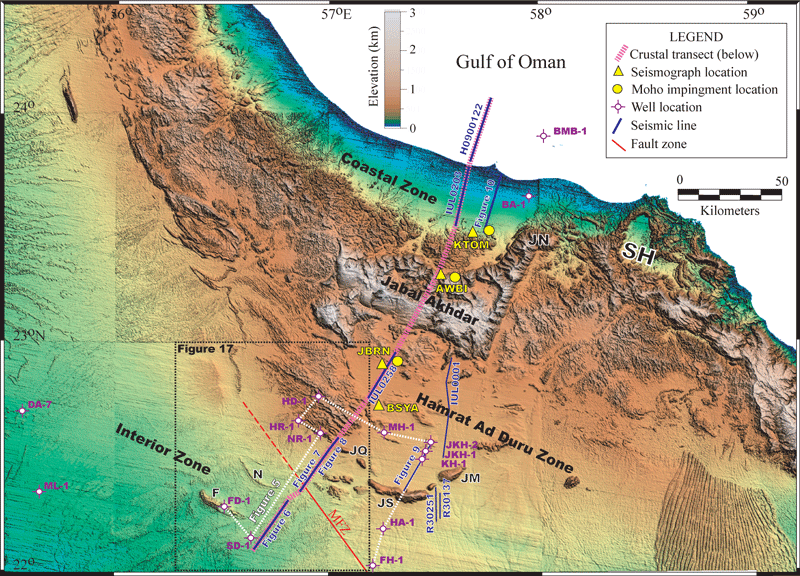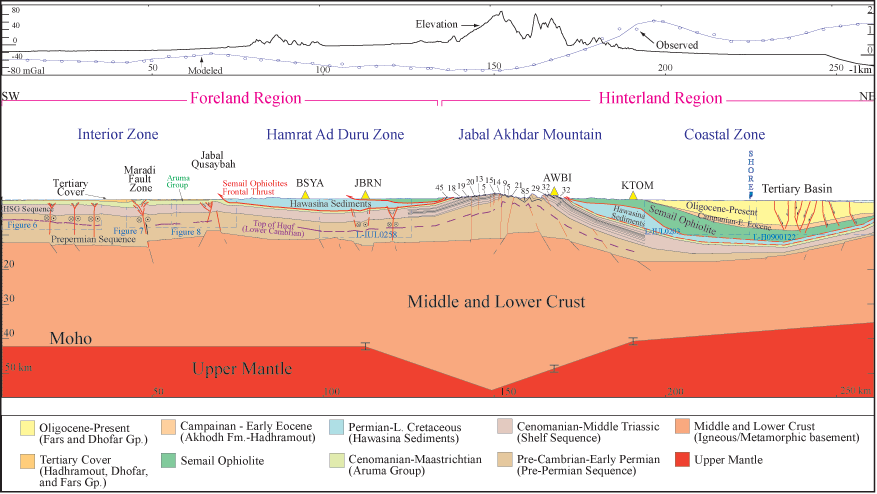The Cornell Oman Project
Project Summary:
The main objective of the Cornell Oman research project is to decipher the shallow and deep crustal structure of the Oman Mountains. This mountain belt is the best type-example of the Earth's ophiolite complex, i.e., the Semail Ophiolite. Though numerous studies have been conducted to better understand the surface geology and the tectonic setting of the Oman ophiolite, very little information is available on the subsurface structure of this region, hence the importance of the Cornell project.
We have used diversified geophysical and seismologic databases and techniques to map the crustal structure of the Oman Mountains. In doing so, we were able to better define the geometry of the basement and the Moho as well as the subsurface geometry of the Semail Ophiolite.
We thank the Oman Ministry of Oil and Gas and the Sultan Qaboos University for their support and for making the Cornell research project a success. We also thank GeoArabia for giving us the permission to post the pdf files of our published research on this Cornell website.

Simplified plate tectonic setting of the Arabian Plate. Oil (green) and gas (red) fields are shown. Base map from Sharland et al. (2001); plate motion after Kensaku Tamaki, Ocean Research Institute, University of Tokyo [http://manbow.ori.u-tokyo.ac.jp]. This map also indicates the location for the figure below. Al-Lazki et al. (GeoArabia, 2002), see publications.

Topographic map of the study area showing wells and seismic reflection lines (blue) locations. Shown in this map are the three structural zones: Coastal Zone, Hamrat Ad Duru Zone, and Interior Zone. The yellow triangles and circles show seismic station locations and the corresponding approximate Ps-Moho impingement location, respectively. Abbreviated text shown on map stands for the following names, SH: Saih Hatat, JQ: Jabal Qusaybah, JS: Jabal Salakh, JM: Jabal Madmar, JN: Jabal Nakhl, MFZ: Maradi Fault Zone, N: Natih structure, and F: Fahud structure. Base map is a shaded relief representation of topography data available at Cornell University. Al-Lazki et al. (GeoArabia, 2002), see publications.

The complete transect of the crust and parts of the upper mantle from the interior of Oman in the southwest, across the Jabal Akhdar Mountain and in the hinterland in the northeast. Also, shown observed and model Bouguer gravity values, with the corresponding elevation along the transect. The transect depicts important stratigraphic sequences and formations, and structural relations. Red lines indicate faults and black arrows indicate relative motion along the fault. 2-D seismic profiles location along the transect are indicated by dashed blue and green rectangles. The Semail Ophiolites frontal thrust is delineated at the sole of the Hawasina Sediments, and a bold red line indicates the sole of the igneous ophiolite body. Dip information of the Jabal Akhdar Mountain are shown along the surface of the structure. The transect also shows locations of deployed seismic stations (yellow triangles) and the corresponding, projected, impinging locations are shown as error bars. Al-Lazki et al. (GeoArabia, 2002), see publications.
For questions or comments, please contact Muawia Barazangi: mb44@cornell.edu.
Last updated: March 2016